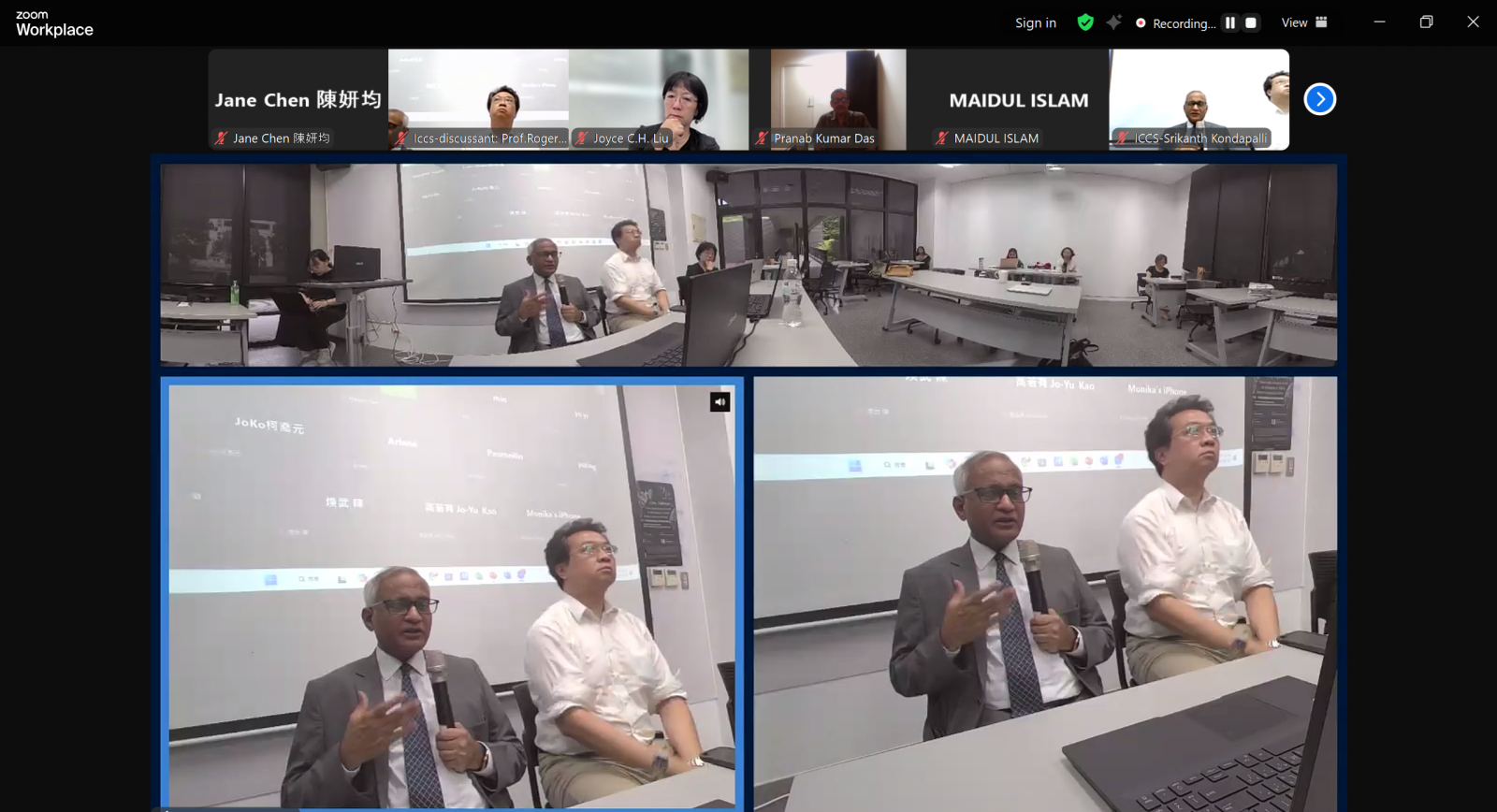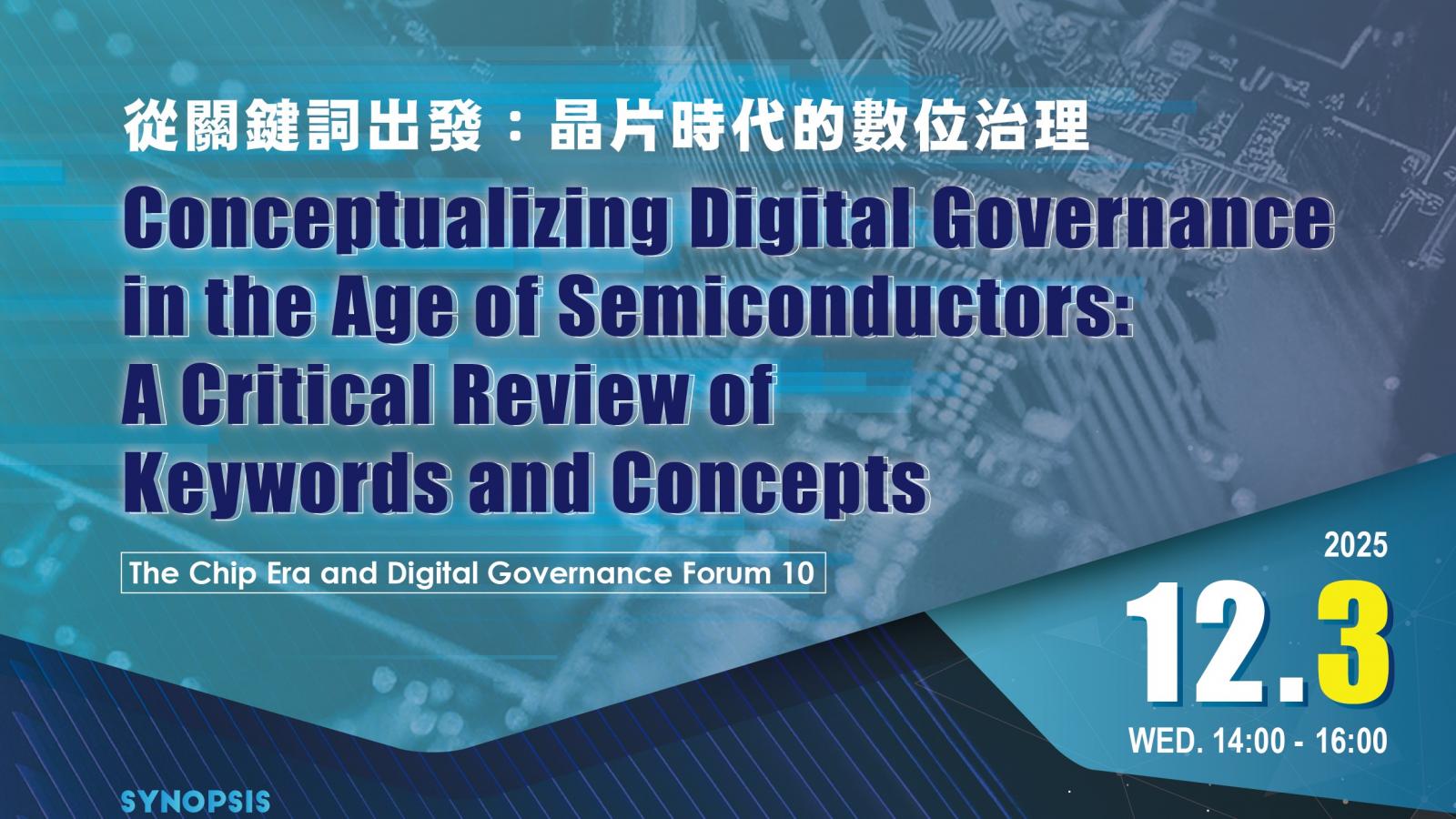

側記|晶片外交:全球科技與地緣政治重塑中的台印關係
2025-05-19
Topic|Chip Diplomacy: Taiwan-India Relations Amid the Reshaping of Global Techno-Geopolitical Order
Time|2025/05/19, 14:00 – 16:00
Venue|Room 102, HC Building 3, Guangfu Campus, National Yang Ming Chiao Tung University (NYCU), Hsinchu, Taiwan
Speaker|Srikanth Kondapalli (Professor, China studies, Centre for East Asian Studies, School of International Studies, Jawaharlal Nehru University
Moderator|Joyce C.H. Liu (Director/Professor, International Center for Cultural Studies, National Yang Ming Chiao Tung University)
Discussants|Roger Chifeng Liu (Assistant Professor, Graduate Institute of Asia-Pacific Affairs, National Sun-Yat-sen University); ICSSR-NSTC Project Researchers (ICCS-NYCU, TAIWAN & Center for Studies in Social Sciences, Calcutta, India.
Event Info|LINK
Event Photo|LINK
Reported by|Dr. Poonam Sharma
Sub-project|Subproject II: The Chip Era and Digital Governance
Convener|Joyce C.H. Liu

The session started with Prof. Joyce C.H. Liu, director of the International Center for Cultural Studies (ICCS), welcoming and addressing the Speaker, the discussants, and the audience. Prof. Liu addresses the event under “The Chip Era & Digital Governance”. She reflects on the strategic hold of the semiconductor industry in the 21st century by structuring global power. Prof. Liu explains how ‘Chip’ is now the backbone of this emerging power struggle that produces 5G, a Surveillance regime, and an automated world space. Moreover, the competence to meet the production and supply chain demands signifies the Geopolitical Power ship. While the United States has already started to work and plan for China’s rise, China has diversified its growth through its Digital Silk Road Policy.
Taiwan leads the Global Semiconductor industry, whereas India, backed by their Semiconductor Program, is a Global alternative to enhance the India-Taiwan Semiconductor Collaboration. Thus, how does available technology impact our daily lives, and how does technology influence and discipline the suppressed population that has emerged as a part of this so-called ‘Chip Diplomacy’?
With this note, Prof. Liu invites Prof. Kondapalli to address the issues revolving around Global Chip Diplomacy.
To reflect on how diplomacy works, Prof. Kondapalli discusses the fundamental issues that influence and impact foreign policy. In the past, foreign policy was affected by problems like Climate change, energy, etc. However, today, the semiconductor sector has been influencing foreign policy. While citing the difference between traditional and contemporary foreign policy, it was explained that earlier, foreign relations existed between states, while today, they have widened to state-to-multinational companies. It was after the 90s that the powerful, termed as (non-state), multinational corporations took hold of the global order. On a functional level, ‘Chip Diplomacy’ is defined as the usage by foreign ministries of negotiable deals, trading, production, and the circulation of all these globally. Taiwan’s Semiconductor exchanges with European nations and India were cited as an example to explain the strategic use of Semiconductor production and Supply chain as the contemporary ‘Chip Diplomacy’
Next, Prof. Kondapalli, while discussing the dynamics of Chip Diplomacy, explains how the National Power Index is used to enhance their Global Power. Therefore, countries willing to grow their power are increasing their semiconductor dynamics while considering the economic benefits of semiconductors in the 21st century, which produce the highest per capita income. Next, semiconductors have been increasingly used in complex defense-making strategies. While reflecting on the state’s active and hostile reaction to investing and engaging in the semiconductor industry, Prof. Kondapalli discussed the various interactions that promote the semiconductor industry within the nation and worldwide circulation. The state-to-state interaction and state-to-national companies mitigate the ‘Chip Diplomacy’.
Prof. Kondapalli explains that today, due to globalization, the power of big multinationals like TSMC, Micron, Samsung, etc. extends even beyond the state sometimes. However, the state's role remains significant because it extends overarching guarantees regarding negotiations and proceedings. The state’s intervention in the trade agreements and joint ventures (JVs) for Research and Development procedures between states is crucial for developing the Semiconductor Industry. This will be done by explaining the state's relations with bodies like the WTO and how it operates, processes, and functions in the semiconductor industry. While providing the example of the Trump Administration, the state's role in trade negotiations, such as the import of specific goods and services, is narrated. It explains how States and large conglomerates conduct promotions and interactions in the form of investments, joint ventures, trade exchanges, and incentive standardization surrounding the semiconductor sector on the global platform.
Next, the literature section starts with the three main aspects of international relations, which begin with realism. This suggests that a conflict is emerging due to high technology, which signifies that technological dominance can become a source of concern and anarchy. At the same time, if a nation considers another nation a matter of concern, it is depicted through export control measures. For instance, the United States banned semiconductor exports to countries it deemed a threat. Therefore, the works of Lee Kai-fu on Cooperation, Alex Capri on Techno-nationalism, Julia Christina Hess and Jan–Peter Kleinhans on ‘Chip Diplomacy -Analysis of Technology Partnerships’, and Chris Miller on Technology denial—export controls, sanctions, and diplomatic pressure. The Literature Review explains that economic interdependence between countries could resolve conflicts and enhance relationships between countries. While summarizing the literature review, it is stated that the Semiconductor Industry cooperation has been the major Science and Technology project for the last two decades, as a liberal value system has acted as a significant influencer. Thus, interdependence and realism are regarded as the primary explanations for the Semiconductor Industry regarding foreign policy and IR theories.
Prof. Kondapali, while explaining the ‘Techno-geopolitical order,’ mentions the impact of supply chain disruptions. During the COVID-19 pandemic, semiconductor supply systems faced severe setbacks. In response, countries like Australia, Japan, and India have signed the ‘Supply Chain Resilience Act’. ‘Techno-nationalism’ is discussed through the reaction of the United States to China’s Made in China 2025. Although China aims to become a world power in multiple areas, its objective to domestically produce 80% of the semiconductors can be of concern to countries like the United States. Even more concerning is that China has been using some of the semiconductor technology in the military domain, with China’s growing role in one or other global conflicts. Therefore, China’s regressive ambition to dominate and navigate the Global Semiconductor Industry and the disruptions in the worldwide supply chain caused by the pandemic and shortages in skilled labor are significant concerns of the techno-geopolitical order.
Therefore, the global players and market share holders of the Semiconductor Industry are the United States at 12 percent, Taiwan at 50 percent, South Korea at 13 percent, China at 8 percent, Japan at 4 percent, and the European Union at 8 percent. In the coming years, Semiconductor manufacturers’ capacity is projected to reach 404 million wafers, and the Global market will be valued at nearly 700 billion in 2025, with a total growth projection of 7 percent. At the same time, the advanced node capacity is expected to grow even faster, at around 12% annually, with strong demand in sectors such as data centers, AI, and high–performance computing. Significantly, Taiwan is the world’s top semiconductor manufacturer, with TSMC leading the forefront, exporting chips worth $150 billion in 2022. Therefore, it is argued that increasing AI dominance defines our interactions with a robust and expanding semiconductor industry that has recently impacted international relations.
Moreover, when discussing the India–Taiwan Semiconductor friendship, the advantages of both nations are thoroughly discussed, starting with the benefits the India-Taiwan Semiconductor Industry will bring to the Taiwanese side: first, India’s cost advantage and government incentives make it an attractive destination for Taiwanese manufacturers seeking to diversify their production bases. Second, India boasts around 20 percent of the world’s semiconductor design workforce, offering Taiwanese firms access to a vast pool of skilled designers and engineers. Third is the innovation drive, cost reduction, and time to market for new products, proving more competitive for the Taiwanese firms. Fourth is the diversification of labor-intensive operations and moving up the value chain. Fifth, his collaboration will allow Taiwanese firms to leverage India’s chip design, assembly, and testing strengths, considering Taiwan’s manufacturing expertise. Finally, India’s software, design services, and engineering strengths complement Taiwan’s hardware expertise, fostering innovation in AI, IoT, 5G, and other emerging technologies. Thus, most importantly, these exchanges will reduce reliance on China. Next, Prof. Kondapalli also explains the advantages, beginning with the boost in India’s Semiconductor production and a billion-dollar growing industry by 2030. Next, establishing domestic fabs and attracting Taiwanese suppliers would strengthen India’s position within the global electronics value chain and support the government’s ‘Make in India’ initiative. The whole process would drive capital flows, create high-value jobs, and stimulate the broader tech ecosystem in India. Moreover, the entire process offers India technical know-how and a depth of supply chain. Finally, the whole process strengthens India’s software and AI development in the global order.
To support the semiconductor industry, the Indian Government has offered to cover up to 50 percent of project costs for approved semiconductor projects, with an investment ceiling of $10 billion. The government has also initiated a $15.2 billion fund to establish India as a global chip manufacturing hub, locating the fab within designated industrial corridors such as the Delhi-Mumbai Industrial Corridor.
Significantly, six collaborative semiconductor fabs are planned for India and Taiwan collaborations. The most extensive collaboration between India and Taiwan is the Powerchip Semiconductor Manufacturing Corporation (PSMC), which collaborates with Tata Electronics to manufacture Chips for Gujarat and Assam. Foxconn’s partnership with HCL to establish a semiconductor manufacturing facility near Uttar Pradesh’s Jewar Airport, with an investment of $433.6 million. Additionally, there are other JVs ongoing in Gujarat and Surat. While discussing the collaboration ecosystem between India and Taiwan, it is brought into the limelight that presently around 250 Taiwanese companies are in India, with companies like Foxconn, Acer (electronics), Feng Tay, and Pou Chen (footwear) having established large-scale manufacturing units in India. Recently, Taiwanese firms have also invested in India’s automotive industry with a strong focus on electric vehicle (EV) components and advanced battery technologies.
With all these references and existing data, it is concluded that India and Taiwan understand that cooperation is mutually beneficial. At the same time, Taiwan can access India’s scale and market, which holds enormous potential for future capital inflow. India upgrades its technological power in the geopolitical order. These projects are strengthening India-Taiwan bilateral relations. However, despite the problems related to an underdeveloped ecosystem, bureaucratic delays, cost overruns, and other issues, Prof. Kondapalli explains that India and Taiwan are collaborating.
After the speaking session, Dr. Roger Liu discussed Prof. Kondapalli’s presentation, where he started by reflecting on India’s Semiconductor ventures in the past, before the United States, with Japan, with the European Union (EU), and recently with the Taiwanese companies (PSMC and Hi-max). A well-crafted chart presented the comparisons on compatibility as low, medium, and high based on various key areas and segments of the Semiconductor Industry. The drawbacks and benefits drafted out of the collaboration were well explained and argued from Taiwan’s perspective. This refers to key areas like IC Design, Advanced Node Fabs, Mature Node Fabs, ATMP/OSAT, Talent Development, Supply Chain Integration, and Joint R&D. With comparisons in India and Taiwan’s Advantages, Synergy Potential, Conflict competitiveness, and Key Enablers or Mitigation Strategies.
Lastly, the ICSSR-NSTC scholars, started by Prof. Maidul Islam, posed some crucial yet interesting questions to conclude the event. The questions are: How does the growing closeness of Bangladesh and Pakistan with China impact the India-Taiwan Semiconductor Chip Diplomacy? Most Semiconductor Investments have taken place in north, west, and south India, but there has been less emphasis on the eastern part, particularly in the states of Orissa and West Bengal. At the same time, the other scholars touched upon the questions on architecture, resources, and equipment feasibility in West and South India for semiconductor facilities, with questions on migration, securitization, and impact on technology and soft power on the vulnerable groups in the present times and under the AI governance setups.
近期新聞 Recent News



New Publication | Writing against Occupation: Palestine and Beyond (CJD Booklet No.6)
2025-11-12
more